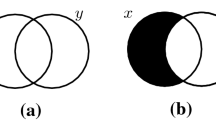Abstract
Some problems posed years ago remain challenging today. In particular, the Robbins problem, which is still open and which is the focus of attention in this paper, offers interesting challenges for attack with the assistance of an automated reasoning program; for the study presented here, we used the program OTTER. For example, when one submits this problem, which asks for a proof that every Robbins algebra is a Boolean algebra, a large number of deduced clauses results. One must, therefore, consider the possibility that there exists a Robbins algebra that is not Boolean; such an algebra would have to be infinite. One can instead search for properties that, if adjoined to those of a Robbins algebra, guarantee that the algebra is Boolean. Here we present a number of such properties, and we show how an automated reasoning program was used to obtain the corresponding proofs. Additional properties have been identified, and we include here examples of using such a program to check that the corresponding hand-proofs are correct. We present the appropriate input for many of the examples and also include the resulting proofs in clause notation.
Similar content being viewed by others
References
Boyer R. and Moore J, A Computational Logic, Academic Press, New York (1979).
Boyer R. and Moore J, A Computational Logic Handbook, Academic Press, San Diego (1988).
Henkin L., Monk J., and Tarksi A., Cylindrical Algebras. Part I, North-Holland, Amsterdam (1971).
Herbrand J., ‘Investigations in proof theory: The properties of propositions’, pp. 525–581 in From Frege to Gödel: A Source Book in Mathematical Logic, ed. J. van Heijenoort, Harvard University Press, Cambridge, Massachusetts (1967).
Huntington E., ‘New sets of independent postulates for the algebra of logic, with special reference to Whitehead and Russell's Principia Mathematica’, Trans. AMS 35, 274–304 (1933).
Huntington E., ‘Boolean algebra. A correction’, Trans. AMS 35, 557–558 (1933).
Kapur, D. and Zhang, H., RRL: Rewrite Rule Laboratory User's Manual, Technical Report 89-03, Department of Computer Science, University of Iowa (1989).
Knuth D. and Bendix P., ‘Simple word problems in universal algebras’, pp. 263–297 in Computational Problems in Abstract Algebra, ed. J. Leech, Pergamon Press, New York (1970).
McCharen J., Overbeek R., and Wos L., ‘Complexity and related enhancements for automated theorem-proving programs’, Computers and Mathematics with Applications 2, 1–16 (1976).
McCharen J., Overbeek R., and Wos L., ‘Problems and experiments for and with automated theorem-proving programs’, IEEE Trans. Comp. C25, 773–782 (1976).
McCune, W., OTTER 2.0 Users Guide, Argonne National Laboratory Report ANL-90/9 (1990).
Robinson G. and Wos L., ‘Paramodulation and theorem proving in first-order theories with equality’, pp. 135–150 in Machine Intelligence 4, ed. B. Meltzer and D. Michie, Edinburgh University Press, Edinburgh (1969).
Stickel M., ‘A unification algorithm for associative-commutative functions’, J. ACM 28, 423–434 (July 1981).
Veroff, R. and Wos, L., ‘The linked inference principle, I: The formal treatment’, Preprint MCS-P160-0690, Mathematics and Computer Science Division, Argonne National Laboratory (1990).
Winker, S., ‘Absorption and idempotency criteria for a problem in near-Boolean algebras’, Preprint MCS-P177-0990, Mathematics and Computer Science Division, Argonne National Laboratory (1990).
Winker S. and Wos L., ‘Procedure implementation through demodulation and related tricks’, pp. 109–131 in Proceedings of the Sixth International Conference on Automated Deduction, Springer-Verlag Lecture Notes in Computer Science, Vol. 138, ed. D. W. Loveland, Springer-Verlag, New York (1982).
Wos L., Automated Reasoning: 33 Basic Research Problems, Prentice-Hall, Englewood Cliffs, New Jersey (1988).
Wos L., Overbeek R., and Henschen L., ‘Hyperparamodulation: A refinement of paramodulation’, pp. 208–219 in Proceedings of the Fifth International Conference on Automated Deduction, Springer-Verlag Lecture Notes in Computer Science, Vol. 87, ed. R. Kowalski and W. Bibel, Springer-Verlag, New York (1980).
Wos L., Robinson G., Carson D., and Shalla L., ‘The concept of demodulation in theorem proving’, J. ACM 14, 698–709 (1967).
Wos L., Winker S., Veroff R., Smith B., and Henschen L., ‘A new use of an automated reasoning assistant: Open questions in equivalential calculus and the study of infinite domains’, Artificial Intelligence 22, 303–356 (1984).
Wos L., Winker S., Veroff R., Smith B., and Henschen L., ‘Questions concerning possible shortest single axioms in equivalential calculus: An application of automated theorem proving to infinite domains’, Notre Dame J. Formal Logic 24, 205–223 (1983).
Author information
Authors and Affiliations
Additional information
This work was supported by the Applied Mathematical Sciences subprogram of the Office of Energy Research, U.S. Department of Energy, under Contract W-31-109-Eng-38.
Rights and permissions
About this article
Cite this article
Winker, S. Robbins algebra: Conditions that make a near-boolean algebra boolean. J Autom Reasoning 6, 465–489 (1990). https://doi.org/10.1007/BF00244359
Received:
Issue Date:
DOI: https://doi.org/10.1007/BF00244359



